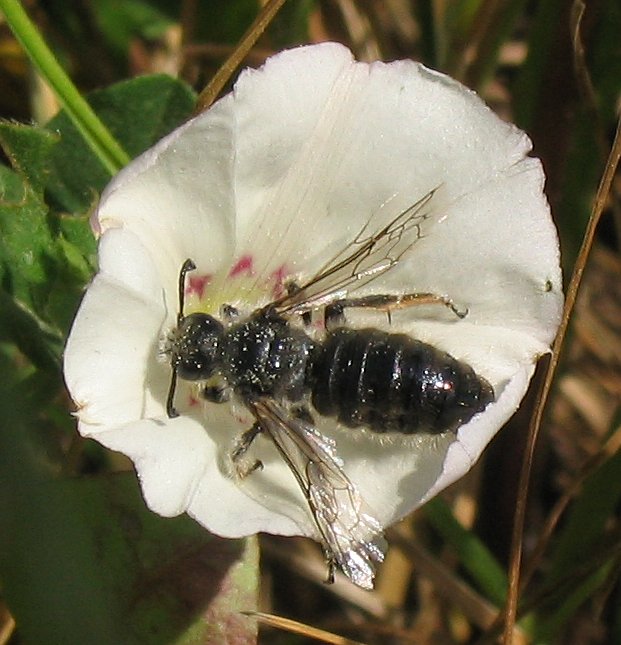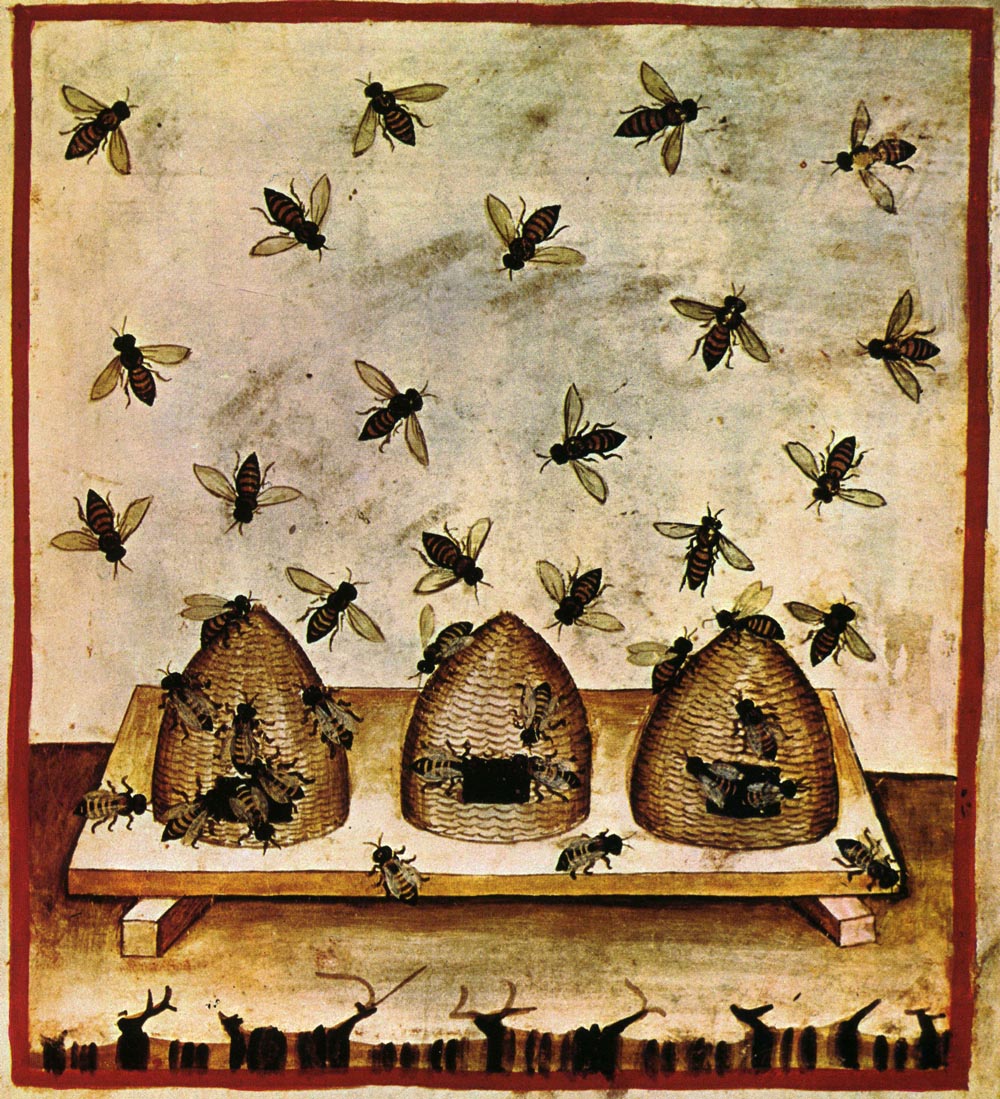|
Pollen Theft
Pollen theft, also known as pollen robbery or floral larceny, occurs when an animal actively eats or collects pollen from a plant species but provides little or no pollination in return. Pollen theft was named as a concept at least as early as the 1980, and examples have been documented well before that. For example, native honey bees were documented 'stealing' large amounts of pollen from the large, bat-pollinated flowers of ''Parkia clappertoniana'' in Ghana in the 1950s. Nevertheless, pollen theft has typically received far less research attention than nectar robbing, despite the more direct consequences on plant reproduction. Pollen thieves Few pollen-collecting animals are obligate pollen thieves. Rather pollen theft generally arises from a mismatch between the morphology or behaviour of a pollen collecting animal and the morphology or phenology of a flowering plant species. The clearest examples of pollen theft are when pollen-collecting insects visit only the male (po ... [...More Info...] [...Related Items...] OR: [Wikipedia] [Google] [Baidu] |
Halictidae
Halictidae is the second-largest family of bees (clade Anthophila) with nearly 4,500 species. Halictid species are an extremely diverse group that can vary greatly in appearance. These bees occur all over the world and are found on every continent except Antarctica. Usually dark-colored (frequently brown or black) and often metallic, halictids are found in various sizes, colors and patterns. Several species are all or partly green and a few are red, purple, or blue. A number of them have yellow markings, especially the males, which commonly have yellow faces, a pattern widespread among the various families of bees. The family is one of many with short tongues and is best distinguished by the arcuate (strongly curved) basal vein found on the wing. Females in this family tend to be larger than the males. They are commonly referred to as "sweat bees" (especially the smaller species), as they are often attracted to perspiration. Ecology Most halictids nest in the ground, often in ... [...More Info...] [...Related Items...] OR: [Wikipedia] [Google] [Baidu] |
Bee With Pollen On Aloe (5860287315)
Bees are winged insects closely related to wasps and ants, known for their roles in pollination and, in the case of the best-known bee species, the western honey bee, for producing honey. Bees are a monophyletic lineage within the superfamily Apoidea. They are presently considered a clade, called Anthophila. There are over 16,000 known species of bees in seven recognized biological families. Some speciesincluding honey bees, bumblebees, and stingless beeslive socially in colonies while most species (>90%)including mason bees, carpenter bees, leafcutter bees, and sweat beesare solitary. Bees are found on every continent except Antarctica, in every habitat on the planet that contains insect-pollinated flowering plants. The most common bees in the Northern Hemisphere are the Halictidae, or sweat bees, but they are small and often mistaken for wasps or flies. Bees range in size from tiny stingless bee species, whose workers are less than long, to ''Megachile pluto'', the la ... [...More Info...] [...Related Items...] OR: [Wikipedia] [Google] [Baidu] |
Reproductive Assurance
Reproductive assurance (fertility assurance) occurs as plants have mechanisms to assure full seed set through selfing when outcross pollen is limiting. It is assumed that self-pollination is beneficial, in spite of potential fitness costs, when there is insufficient pollinator services or outcross pollen from other individuals to accomplish full seed set.. This phenomenon has been observed since the 19th century, when Darwin observed that self-pollination was common in some plants. Constant pollen limitation may cause the evolution of automatic selfing, also known as autogamy. This occurs in plants such as weeds, and is a form of reproductive assurance. As plants pursue reproductive assurance through self-fertilization, there is an increase in homozygosity , and inbreeding depression, due to genetic load, which results in reduced fitness of selfed offspring. Solely outcrossing plants may not be successful colonizers of new regions due to lack of other plants to outcross with, so ... [...More Info...] [...Related Items...] OR: [Wikipedia] [Google] [Baidu] |
Grevillea Barklyana
''Grevillea barklyana'', also known as gully grevillea or large-leaf grevillea, is a species of flowering plant in the family Proteaceae and is endemic to Western Gippsland in Victoria, Australia. It is an erect shrub or small tree, with mostly pinnatifid leaves with two to eleven lobes, and whitish pink to fawn flowers. Description ''Grevillea barklyana'' is an erect shrub or small tree that typically grows to a height of up to . Its leaves are mostly pinnatifid, narrowly egg-shaped to elliptic in outline, long and wide with two to eleven lobes long, the lower surface densely covered with curly hairs. The flowers are arranged in groups near the ends of branches on a rachis long, and are whitish pink to fawn with a glabrous, pale pink to pale crimson style. The pistil is long and covered with silky to woolly hairs. Flowering mostly occurs from October to December and the fruit is a follicle long. Taxonomy ''Grevillea barklyana'' was first formally described in 1870 ... [...More Info...] [...Related Items...] OR: [Wikipedia] [Google] [Baidu] |
Melastoma Affine
''Melastoma affine'', also known by the common names blue tongue or native lassiandra, is a shrub of the family Melastomataceae. Distributed in tropical and sub-tropical forests of India, South-east Asia and Australia, it is a plant of rainforest margins. Bees are the principal pollinators of this species. Taxonomy ''Melastoma affine'' was first described by Scottish botanist David Don in 1823. The taxonomy of the genus ''Melastoma'' is tricky, requiring a complete revision. Early genetics studies were published from 2001, – see also the erratum. through to recently, but a revision based on them has yet to be. In 2001 Karsten Meyer proposed a revision in which this species and other species were subsumed within the species ''Melastoma malabathricum''. In Australia, currently most authorities do not accept this; instead the naturally occurring populations in WA, NT, Qld and northeastern NSW remain recognised as this species ''M. affine'', except by authorities in Qld. Synon ... [...More Info...] [...Related Items...] OR: [Wikipedia] [Google] [Baidu] |
Buzz Pollination
Buzz pollination or sonication is a technique used by some bees, such as solitary bees to release pollen which is more or less firmly held by the anthers. The anthers of buzz-pollinated plant species are typically tubular, with an opening at only one end, and the pollen inside is smooth-grained and firmly attached. With self-fertile plants such as tomatoes, wind may be sufficient to shake loose the pollen through pores in the anther and accomplish pollination. Visits by bees may also shake loose some pollen, but more efficient pollination of those plants is accomplished by a few insect species who specialize in sonication or buzz pollination. In order to release the pollen, solitary bees are able to grab onto the flower and move their flight muscles rapidly, causing the flower and anthers to vibrate, dislodging pollen. Pollination involving vibrations is called buzz pollination. Honeybees cannot perform buzz pollination. About 9% of the flowers of the world are primarily pollin ... [...More Info...] [...Related Items...] OR: [Wikipedia] [Google] [Baidu] |
Clusia
''Clusia'' is the type genus of the plant family Clusiaceae. Comprising 300-400 species, it is native to the tropics of the Americas. The genus is named by Carl Linnaeus in honor of the botanist Carolus Clusius. The closest relatives of ''Clusia'' are the neotropical genera '' Chrysochlamys'', '' Tovomita'', '' Dystovomita'' and '' Tovomitopsis''. Together with ''Clusia'', these genera form the tribe Clusieae, where the fruit is a fleshy capsule with arillate seeds. The distribution ranges from the Florida Keys and southern Mexico to southernmost Brazil, and from near sea level to at least 3500 m altitude in the northern Andes. Species of ''Clusia'' are a characteristic component of a number of Neotropical vegetation types, and may even be dominant, as is often seen in montane forests of the Greater Antilles. Most species are found in lowland or montane rainforests, but some occur in drier habitats such as the restingas of Brazil, caribbean coastal scrub and dry interan ... [...More Info...] [...Related Items...] OR: [Wikipedia] [Google] [Baidu] |
Aloe Maculata
''Aloe maculata'' (syn. ''Aloe saponaria''), the soap aloe or zebra aloe, is a Southern African species of aloe. Local people in South Africa know it informally as the ''Bontaalwyn'' in Afrikaans, or ''lekhala'' in the Sesotho language. Description It is a very variable species and hybridizes easily with other similar aloes, sometimes making it difficult to identify. The leaves range in colour from red to green, but always have distinctive "H-shaped" spots. The flowers are similarly variable in colour, ranging from bright red to yellow, but are always bunched in a distinctively flat-topped raceme. The inflorescence is borne on the top of a tall, multi-branched stalk and the seeds are reputedly poisonous. Taxonomy This species was previously known as ''Aloe saponaria'' (a name that came from the Latin ''"sapo"'' meaning soap, as the sap makes a soapy lather in water). Its currently accepted name, according to the South African National Biodiversity Institute (SANBI), is ''Aloe m ... [...More Info...] [...Related Items...] OR: [Wikipedia] [Google] [Baidu] |
Beekeeping
Beekeeping (or apiculture) is the maintenance of bee colonies, commonly in man-made beehives. Honey bees in the genus ''Apis'' are the most-commonly-kept species but other honey-producing bees such as '' Melipona'' stingless bees are also kept. Beekeepers (or apiarists) keep bees to collect honey and other products of the hive: beeswax, propolis, bee pollen, and royal jelly. Pollination of crops, raising queens, and production of package bees for sale are other sources of beekeeping income. Bee hives are kept in an apiary or "bee yard". The keeping of bees by humans, primarily for honey production, began around 10,000 years ago. Georgia is known as the "cradle of beekeeping" and the oldest honey ever found comes from that country. The 5,500-year-old honey was unearthed from the grave of a noblewoman during archaeological excavations in 2003 near the town Borjomi. Ceramic jars found in the grave contained several types of honey, including linden and flower honey. Domes ... [...More Info...] [...Related Items...] OR: [Wikipedia] [Google] [Baidu] |
Honey Bee
A honey bee (also spelled honeybee) is a eusocial flying insect within the genus ''Apis'' of the bee clade, all native to Afro-Eurasia. After bees spread naturally throughout Africa and Eurasia, humans became responsible for the current cosmopolitan distribution of honey bees, introducing multiple subspecies into South America (early 16th century), North America (early 17th century), and Australia (early 19th century). Honey bees are known for their construction of wiktionary:perennial, perennial Colony (biology), colonial nests from Beeswax, wax, the large size of their colonies, and surplus production and storage of honey, distinguishing their hives as a prized foraging target of many animals, including honey badgers, bears and human hunter-gatherers. Only eight surviving species of honey bee are recognized, with a total of 43 subspecies, though historically 7 to 11 species are recognized. Honey bees represent only a small fraction of the roughly 20,000 known species of bees ... [...More Info...] [...Related Items...] OR: [Wikipedia] [Google] [Baidu] |
Trigona
''Trigona'' is one of the largest genera of stingless bees, comprising about 32 species, exclusively occurring in the New World, and formerly including many more subgenera than the present assemblage; many of these former subgenera have been elevated to generic status.Michener, C.D. (2000). The Bees of the World. Johns Hopkins University Press Range ''Trigona'' species occur throughout the Neotropical region, including South and Central America, the Mexican lowlands, and the Caribbean islands. They can occur in forests, savannas, and man made environments. ''Trigona'' bees are active all year round, although they are less active in cool environments. Nesting ''Trigona'' nests are constructed from wax they produce and plant resins they collect. They usually nest in tree cavities and underground. Vulture bees Vulture bees comprise three ''Trigona'' species, and are the only bees known to be scavengers. These bees collect and feed on dead animal flesh. Communication Some spe ... [...More Info...] [...Related Items...] OR: [Wikipedia] [Google] [Baidu] |



_(10243478783).jpg)


